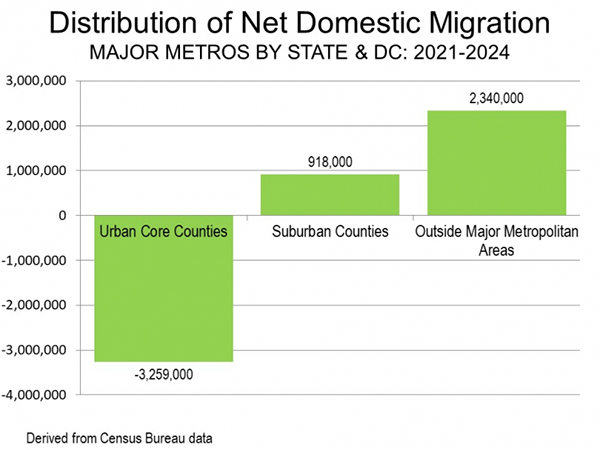
For much of the past century, in both the United States and elsewhere, the inexorable trend has been for people to move from rural areas and towns to ever larger cities, particularly those with vibrant downtown cores such as New York, Chicago, San Francisco, Seattle, and dozens of other iconic American cities. Most visions of the future still view urban cores as the uncontested centers of production, consumption, and culture, with rural areas, small cities, and suburbs relegated to the backwaters of modernity.
A RealClearInvestigations analysis has found that we may be on the cusp of a new era. Urban cores have started to shrink, losing first to the suburbs, then to ever further exurbs, and now to small towns and even rural areas. For the first time since the 19th century, America’s growth pattern favors smaller metros – Fargo, North Dakota, as opposed to Portland, Oregon – many of which once seemed out of favor.
This transformation can be hard to detect because demographers often discuss metropolitan regions, which put city centers at their cores. But this method of classification masks the trend that much of the growth is at the edges of these areas. In virtually all the fastest-growing metros, it has been the further-out exurbs, themselves until recently rural areas, that have experienced most of the expansion. While Raleigh, North Carolina – a sleepy state capital for much of its history – continues to draw migrants from across the country, the most explosive growth is not occurring in the city center but the surrounding “countrypolitan” towns of Apex, Fuquay-Varina, and Zebulon that offer land and a relaxed rural environment along with access to modern amenities.
Between 2010 and 2020, the suburbs and exurbs of the major metropolitan areas gained 2 million net domestic migrants, while the urban core counties lost 2.7 million. The pandemic, which normalized remote work and encouraged people to keep their distance, turbocharged this movement to smaller, less crowded, less expensive housing markets. Through the first four years of this decade, the urban core counties of the major metropolitan areas (over 1,000,000 population) lost 3,259,000 net domestic migrants, three times the rate of loss in the last decade. In contrast, 2.3 million net domestic migrants moved outside the major metros.

Net Domestic Migration
This is a shift the media has underplayed or pinned almost entirely on the pandemic, leaving the impression that small towns and rural areas have little to offer other than a safe haven from illness and crime. In a pre-pandemic 2018 article asking “Can rural America be saved?” The New York Times reported that small cities and towns, particularly in the middle of the country, were “getting old” and facing “relentless economic decline.”
The data suggest the opposite: that Americans are heading back to the land. The steep costs of urban housing and an Amazon economy that allows anybody, anywhere to get almost anything, is rekindling our deep-seated desire for privacy, space, and home ownership.
The New Demographics
The first phase of geographic reinvention began to take shape by 2000, as workers followed both U.S.- and foreign-based companies, which were increasingly expanding into lower-cost states in the Sun Belt and Midwest. Since then, the two most urbanized big states, California and New York, have each lost more than 4 million net domestic migrants. Two other trends – a drop in immigration and fertility rates, especially among people living in big cities – are making it hard for these states to restock their urban populations.
Note: This is the first in a two-part series of the Great Dispersion of Americans across the country.
Read the rest of this piece at: Real Clear Investigations.
Joel Kotkin is the author of The Coming of Neo-Feudalism: A Warning to the Global Middle Class. He is the Roger Hobbs Presidential Fellow in Urban Futures at Chapman University and and directs the Center for Demographics and Policy there. He is Senior Research Fellow at the Civitas Institute at the University of Texas in Austin. Learn more at joelkotkin.com and follow him on Twitter @joelkotkin.
Wendell Cox is principal of Demographia, an international public policy firm located in the St. Louis metropolitan area. He is a Senior Fellow with Unleash Prosperity in Washington and the Frontier Centre for Public Policy in Winnipeg and a member of the Advisory Board of the Center for Demographics and Policy at Chapman University in Orange, California. He has served as a visiting professor at the Conservatoire National des Arts et Metiers in Paris. His principal interests are economics, poverty alleviation, demographics, urban policy and transport. He is author of the annual Demographia International Housing Affordability Survey and author of Demographia World Urban Areas.
Photo: Carlos Oliva via Pexels.
| Attachment | Size |
|---|---|
| distribution-domestic-migration_21-24.jpg | 110.34 KB |












